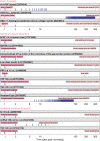Pharmaceutical Prophylaxis of Scarring with Emphasis on Burns: A Review of Preclinical and Clinical Studies
- PMID: 33625898
- PMCID: PMC9142134
- DOI: 10.1089/wound.2020.1236
Pharmaceutical Prophylaxis of Scarring with Emphasis on Burns: A Review of Preclinical and Clinical Studies
Abstract
Significance: The worldwide estimate of burns requiring medical attention each year is 11 million. Each year in the United States, ∼486,000 burn injuries receive medical attention, including 40,000 hospitalizations. Scars resulting from burns can be disfiguring and impair functions. The development of prophylactic drugs for cutaneous scarring could improve the outcomes for burns, traumatic lacerations (>6 million/year treated in U.S. emergency rooms), and surgical incisions (∼250 million/year worldwide). Antiscar pharmaceuticals have been estimated to have a market of $12 billion. Recent Advances: Many small molecules, cells, proteins/polypeptides, and nucleic acids have mitigated scarring in animal studies and clinical trials, but none have received Food and Drug Administration (FDA) approval yet. Critical Issues: The development of antiscar pharmaceuticals involves the identification of the proper dose, frequency of application, and window of administration postwounding for the indicated wound. Risks of infection and impaired healing must be considered. Scar outcome needs to be evaluated after scars have matured. Future Directions: Once treatments have demonstrated safety and efficacy in rodent and/or rabbit and porcine wound models, human testing can begin, such as on artificially created wounds on healthy subjects and on bilateral-surgical wounds, comparing treatments versus vehicle controls on intrapatient-matched wounds, before testing on separate cohorts of patients. Given the progress made in the past 20 years, FDA-approved drugs for improving scar outcomes may be expected.
Keywords: biopharmaceuticals; burns; drugs; pharmaceuticals; scars; wounds.
Conflict of interest statement
The authors do not have any commercial or financial conflicts of interest to declare. This article was written exclusively by the authors without ghostwriters.
Figures









Similar articles
-
Scar-free healing: from embryonic mechanisms to adult therapeutic intervention.Philos Trans R Soc Lond B Biol Sci. 2004 May 29;359(1445):839-50. doi: 10.1098/rstb.2004.1475. Philos Trans R Soc Lond B Biol Sci. 2004. PMID: 15293811 Free PMC article. Review.
-
Release of insulin from PLGA-alginate dressing stimulates regenerative healing of burn wounds in rats.Clin Sci (Lond). 2015 Dec;129(12):1115-29. doi: 10.1042/CS20150393. Epub 2015 Aug 26. Clin Sci (Lond). 2015. PMID: 26310669
-
Synthetic TGF-beta antagonist accelerates wound healing and reduces scarring.FASEB J. 2002 Aug;16(10):1269-70. doi: 10.1096/fj.02-0103fje. Epub 2002 Jun 21. FASEB J. 2002. PMID: 12153996
-
A novel TGF-beta antagonist speeds reepithelialization and reduces scarring of partial thickness porcine burns.J Burn Care Res. 2009 Mar-Apr;30(2):329-34. doi: 10.1097/BCR.0b013e31819a6369. J Burn Care Res. 2009. PMID: 19165091
-
Advances in Research in Animal Models of Burn-Related Hypertrophic Scarring.J Burn Care Res. 2015 Sep-Oct;36(5):e259-66. doi: 10.1097/BCR.0000000000000167. J Burn Care Res. 2015. PMID: 25356852 Review.
Cited by
-
Non-invasive Resonance Raman Spectroscopy provides an early estimation of depth in a pig model of multi-depth burns.Res Sq [Preprint]. 2025 Jun 8:rs.3.rs-6805519. doi: 10.21203/rs.3.rs-6805519/v1. Res Sq. 2025. PMID: 40502750 Free PMC article. Preprint.
References
-
- American Burn Association. Burn Incidence Fact Sheet, Burn Incidence and Treatment in the United States: 2016. https://ameriburn.org/who-we-are/media/burn-incidence-fact-sheet/. (last accessed February 25, 2020).
-
- Weiser TG, Regenbogen SE, Thompson KD, et al. An estimation of the global volume of surgery: a modelling strategy based on available data. Lancet 2008;372:139–144. - PubMed
Publication types
MeSH terms
Substances
LinkOut - more resources
Full Text Sources
Other Literature Sources
Medical
Miscellaneous

